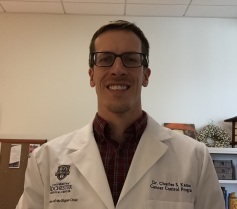The Clinical Research Center (CRC), a pillar of the CTSI, plays host to numerous research studies at the University of Rochester. Charles Kamen, Ph.D., recently used the CRC for his study of psychological distress in cancer survivors.
Kamen discussed his research, and his experience at the CRC, with CTSI Stories.
Tell us a little bit about your research.
I work closely with Karen Mustian, and she’s done a lot of work showing that exercise is effective in reducing side effects in people recovering from cancer. She’s shown that if you give people a home-based exercise intervention — walking regularly and increasing steps to the recommended 10,000 a day, as well as doing a resistance activity — that fatigue goes down over the course of six weeks.
I’m a clinical psychologist and I’m interested in psychological distress. So I was curious if we could use that same exercise intervention to address psychological distress in cancer survivors. I’m also interested, specifically, in psychological distress in gay and lesbian cancer survivors. There’s a lot of evidence that LGBT persons have more stress in general than heterosexual individuals do, probably because of a lifetime of discrimination and prejudice. I’ve shown in past datasets that if you look at LGBT cancer survivors, the same disparities you see in the population as a whole persist in cancer survivorship. So even in the context of cancer, which is very stressful, LGBT survivors have more stress than other cancer survivors.
So I wanted to get a group of LGBT cancer survivors, and their care partners, to come in to an intervention to see if we could study psychological stress. That’s the overall view, and that’s why I’m trying to address health disparities and psychological distress in this underserved population.
How did you come to work at the CRC?
I put together a proposal, and I got a Wilmot Cancer Center seed grant. My study is on cancer survivors and their care partners, and I’m randomizing them to have them either exercise as a pair — a dyad — or to have the survivor exercise alone. So I’m looking at whether people adhere more to an intervention when they have a partner. The thinking is that no one likes to exercise, but if you exercise with someone else, it’s going to increase the chance of you doing it. And if you exercise, that improves your immune system. So to test that, I also needed blood samples.
So there’s an exercise component, which is done in the PEAK lab, and we also need to do blood draws, and for that, one of my colleagues recommended the CRC.
What was your experience like?
The CRC went above and beyond what I expected. First, I wasn’t sure how the blood draws were going to work. I was worried that I was going to need to somehow haul the blood to a lab right away, aliquot it, and freeze it. This would’ve been tricky, because since it’s a partner study, we have two people coming in at a time. So while one person is doing the exercising with my study coordinator, I’m running the other person through the questionnaire. We would’ve needed a third person to transport, aliquot, and freeze the blood.
But the CRC was able to do all of that for me. I just brought the patient in, they drew the blood, and I took the patient down to the PEAK lab for the rest of the assessment. The CRC would spin the blood for me, aliquot it, and freeze it for me in their -20 degree freezer. Then my coordinator could come by a few days later and take it to our -80 freezer. So the convenience of that was fantastic, and I don’t know how it would’ve worked if the CRC hadn’t been able to process the blood for me.
I also knew I was going to have the participants do their physical exercises, and then I was going to have them do some questionnaires and other assessments. But I knew I was going to have to feed them before those 2 hours of other assessments, so my plan was to get yogurt and granola bars or something to offer them. But Ann Miller at the CRC told me that they have snacks there, so they could give meals to the participants. So in addition to the convenience of the blood processing, they also had meals, and we didn’t have to stock a bunch of Gogurt in the PEAK lab.
And how did the study itself go? Any results you care to share?
The LGBT population compared with heterosexuals do indeed have more psychological distress, more fatigue, and they actually report a little less support from their care partners. I didn’t expect that last part.
But over the course of the intervention, the distress for LGBT couples in the dyad comes down pretty sharply, and there’s an increase in the care partner support. Thanks to the pilot data I collected with the help of the CRC, I was able to successfully compete for a major career development award from the National Cancer Institute!

